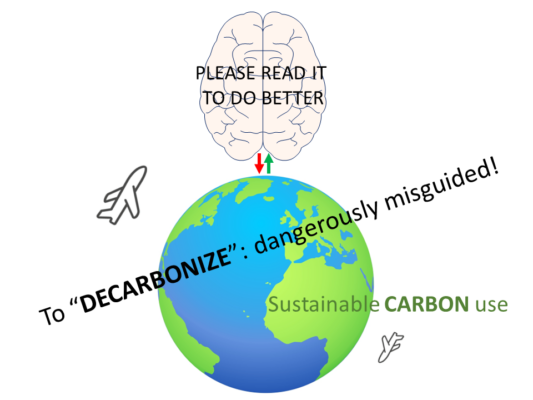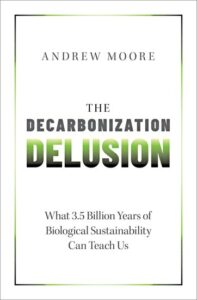A review of “The Decarbonization Delusion—What 3.5 Billion Years of Biological Sustainability Can Teach Us” by Andrew Moore
1 Crucial Insights
Over five years ago, BioEssays contained an editorial by its then editor-in-chief, Andrew Moore, entitled “Why Carbon-Based Fuels Are Not ‘Bad’—Or Will We Ever Learn from Biology?” [1], which in hindsight, can be seen as the manifesto leading to his important, wide-ranging, book which I will discuss here [2].
Why Do I Consider the Book of Such Importance?
Because it contains a deep and thorough analysis of the unfolding climate crisis and its implicit ecological impacts. Of even greater importance, it comes up with superior policy recommendations that should inform all of our debates about safeguarding any kind of future. One of its many strengths is its “non-ideological” perspective: Moore consistently follows where the best scientific analysis leads, both in his examination and in his recommendations for the future.
Make no mistake: several pet “solutions” for climate and energy policies are going up in flames—and I apologize for the metaphor in this context. To address two extreme viewpoints upfront: both the belief that technology will solve everything, so we can continue as usual (in my opinion, frighteningly illustrated by the “artificial intelligence will solve climate change problems” attitude of the usual tech bros) and the stance that “all combustion engines should be replaced by electric alternatives” are thoroughly dismissed in the book.
One-Size-Fits-All Propositions Are Unlikely to Be Sustainable Solutions
As I said, Moore tries to come up with nuanced solutions to highly intricate, complex, but dangerously pressing problems. To give a flavor of the nontechnical aspects of the book (one might say, the “overall framework” in the background) a somewhat longer quote is ideal.
While discussing transport by cars, whether running on fossil fuels, electricity, or hybrid he states: “we need to assess the full-cycle wisdom of the product … the use, death, and recycling of the object. Different technologies … will continue to have different optimal spheres of use, …one-size-fits-all propositions are unlikely to be sustainable solutions. A development that has, unfortunately, not yet occurred is an increase in the average load transported in a private car: usually it is only one person, rarely two or more. Hence, the greatest potential for improving car efficiency is not technological at all: it’s sociological.” (see page 162 of [2]).
2 Starting With the Basics
If one wants to enlighten the public and shape the discussion regarding future climate/energy policies, at least some scientific/technological knowledge has to be presented first. The somewhat vague qualifier “some” hides a universe of choices regarding the scope and depth of the topics to be presented.
Critical Topics Covered
First, the scope of this book is extensive. It covers several critical topics, including the irrefutable evidence that anthropogenic CO2 is the major driver of ongoing and accelerating global warming [3], and the associated climate challenges. It provides detailed comparisons between electric vehicles (EVs), internal combustion engine vehicles (ICEs), and hybrids. The book also discusses the reasons for retaining carbon-based portable fuels, such as existing infrastructure, the speed of energy replenishment, superior energy density, storability, and the hidden long-term costs of EV batteries. Furthermore, it highlights the necessity for mixed energy and manufacturing solutions and examines the emissions of various classes of particulates, their health effects, and sources, noting that tire wear, brakes, and road erosion, in addition to exhausts, are major contributors.
By the way, did the reader ever realize that heavier EVs lead to an increase in unhealthy road erosion?
But this long list of topics can easily be extended: for example, how large-scale policy changes are not so much based on scientific insight, but driven by commercial interests, as reflected in, alas, effective political lobbying, often making use of long-standing unscientific prejudices.
Genetic Modification (GM)
Regarding these, it is worth going into some detail here. Moore nicely points out the commonalities of unfortunate responses to environmental challenges. The correct and praiseworthy impulse to look at the broader impact of human activity on the world is often impaired by instinctive, unnuanced tendencies. Genetic modification (GM) is frequently portrayed as evil (GM food is seen as dangerous, even in the instance of “Golden rice”; see [4]). Of course, in the case of GM there are real environmental risks and possibilities of misuse to consider, but negativity across the board, based on a “do not mess with creation” attitude tips the baby out with the bathwater.
Nuclear Energy
On page 180, Moore cannot resist showing the (in)famous “Nuclear Energy? No thanks” sticker (with a smiling sun in the middle!), advocating a total ban of energy generation from nuclear reactions (see Fig. 1). Again, yes, the precautionary principle of calculating the risk by taking both the likelihood and impact of an accident into account (as also discussed in the book), should make us wary of using nuclear power. It’s worth noting that nuclear processes generate large amounts of energy with very low CO2 emissions. However, the output of highly radioactive waste is a major consideration here as well. In this case, opposing fission-based energy generation, while waiting for fusion-based energy solutions (who knows?), might be one of the defensible positions.

Figure 1. Smiling Sun logo of the anti-nuclear movement used since the late 1970s. (GNU Free Documentation License)
Reflexive, Irrational Prejudices
Moore rightly views the “demonization” of Internal Combustion Engines (ICE) and the concurrent “idolization” of Electric Vehicles (EV) as another instance of reflexive, irrational prejudice. This book serves as a perfect antidote, going into quite some depth about what an all-out replacement of carbon-based fuel-burning engines would imply. Moore shows it to be impossible and wrong-headed to try.
It is important to add that we need to keep the rest of the fossil fuels in the ground. Instead, we should get our building blocks for the synthesis of much-needed materials from, say, the production of CO (using alternative energy sources), which combined with hydrogen (making up “synthesis gas”), is used to make methanol (CO + 2H2 → CH3OH) and hydrocarbons via the Fischer Tropsch method.
3 The Juggernaut of Human Behaviour
The book also touches upon the enormously wasteful production of CO2 and methane (another potent greenhouse gas with very different stability and other relevant characteristics, again expertly discussed by Moore) associated with large-scale meat production and its unsustainability. However, I will not discuss it further here.
Suffice it to say that the total bio-mass of humanity and its livestock is more than 20 times that of all other mammals combined [5] and that, also in this area, instinctive ideas about the “natural order of things”, interfere with recognizing that both livestock farming and the fossil fuel industry are to be considered highly environmentally destructive endeavors [6].
Three Golden Rules
In Chapter 5 “The call to decarbonize”, under the heading “How can we reduce and replace the fossil origin of raw ingredients?”, Moore gives us three golden rules to live by:
- Reduce consumption of absolutely everything.
- Maximize the life span of everything that we use, hence overlapping with 1.
- Choose disposable substances (e.g., packaging of daily items) that have the smallest impact when they end up in refuse.
I would extend these with one more (also overlapping with 1): slowly, but steadily, reducing the world’s population. This would allow a far greater number of mammals and other organisms, whose diversity has plummeted in our present-day mass extinction, to partake in the closed carbon cycle that Moore envisages as a replacement for the current, heavy (and unsustainable) reliance on fossil carbon.
That seems like quite a tall order because of basic biological imperatives such as procreation and our uniquely human trait of “neoteny”; see [7]).
Short-Term Nature of Capitalism
Apart from these, we face irrational tendencies, as discussed earlier, and we are confronted with the extractive short-term nature of capitalism. In this context, Moore highlights these regarding both energy generation and synthetic material recycling. He observes: “it is a race to the bottom: economic competition … leads to some very sobering realities: to survive in a world where an economy can so easily fall into the hand of a politician who cares naught for the environment, other economies are naturally obliged to apply the same measures.” (page 186 of [2]). Add the disproportionate power and wealth of those profiting most from the current economic system (i.e., the billionaire class), and the future looks rather bleak.
4 Not Much to Gripe About
In a review, some criticisms and pointing out errors are almost obligatory. However, the author’s background as an editor shines through: this book is surprisingly free of mistakes and very well written. Over 300 pages of dense information and just a few tiny mistakes. I’ll point out two: one because it is made in the context of a subject matter close to my heart and the other because it is rather funny.
Improvements
During the discussion of ethanol production on page 136, we encounter the following “hiccup title”: “An alcoholic muddle: If you you’re not confused, you’re underinformed!”
The other error occurs in the context of box 1.5 on pages 38–40, beautifully describing glycolysis and oxidative phosphorylation in eukaryotes at some depth. Here separate “arms” of the electron transport chain (ETC) are introduced, with one for the electrons coming from NADH flowing through complexes I, III, and IV to react with O2, all the while building up an H+ gradient. However, when discussing another arm of the ETC, involved in the oxidation of succinate, all four complexes (I, II, III, and IV) are mentioned. But here complex I only gets involved under unusual, pathological, conditions of “reverse electron flow”.
This is important, as a kind of competition between electrons entering at complex I or afterward (with varying numbers depending on alternative substrates like glucose and fatty acids) is believed to have been highly important for the evolution of the eukaryotes. See, for example, [8].
Pocket Edition
Maybe the author can take care of these tiny criticisms in a pocket edition. I talk about such an edition, because I would think it wise to publish one. Here I come to an important point that reflects both the strength and weakness of the book. It seems to me to actually contain three books in one:
- the scientific primer about the biological carbon cycles in quite some depth (I recognize the scientist’s tendency to explain the beauty of it all),
- the highly reasoned and almost completely quantitative comparison of alternatives to fossil fuels, both in energy generation and as starting material for chemical synthesis, and
- the analysis of what needs to be done (a recipe book for a possible livable future) including the forces we are up against.
Reading it from cover to cover is thus highly rewarding, but probably also somewhat challenging (as the author himself is aware, dealing with this issue by suggesting alternative ways of using the book). To my mind, that pocket edition should still inform the reader sufficiently about the natural carbon cycles, explaining why we are currently outside of a stable cycle, and link that directly with a recipe book of dos and don’ts. Maybe that could be reflected in a more “positive” title (not so much combatting a mistaken attitude), for example, “Towards a Sustainable Future – What 3.5 Billion Years of Biological Evolution Can Teach Us”?
But whether Moore decides to condense it or not, for this reader, the book’s message is clear and important. Moreover, the tremendous amount of work involved in this crucial study was much appreciated.

Figure 2. The green arrow represents our complete dependence on Earth, while the red arrow symbolizes our actions as if we are not bound by this reality. (© D. Speijer)
5 Conclusion
The extractive nature of free-market capitalism cannot prevent catastrophic climate change and ecological collapse. In our efforts to avert these crises, we are often led by dangerous, irrational misconceptions that could even make the problems worse, such as the hasty push for “decarbonization.” In the book, the author explains how we might develop better, mixed alternative strategies.
For example, aviation is highlighted as an area where carbon-based fuels are essential. Moore argues for using non-fossil-based carbon fuels combined with a significant reduction in flights. The kerosene consumed by aviation accounts for less than one-third of the diesel fuel and heating oil used in industry and homes.
References
[1] A. Moore, Why Carbon-Based Fuels Are Not ‘Bad’ − Or Will We Ever Learn from Biology?, BioEssays 2019, 41(3), 1900026. https://doi.org/10.1002/bies.201900026
[2] A. Moore, The Decarbonization Delusion – What 3.5 Billion Years of Biological Sustainability Can Teach Us, Oxford University Press, UK, 2024.
[3] Robin McKie, Simply Mind-Boggling: World Record Temperature Jump in Antarctic Raises Fears of Catastrophe, The Guardian 06.04.2024. (accessed May 16, 2024)
[4] Golden rice, Wikipedia (accessed May 16, 2024)
[5] Y. M. Bar-On, R. Phillips, R. Milo, The Biomass Distribution on Earth, Proc. Natl. Acad. Sci. 2018, 115, 6506-6511. https://doi.org/10.1073/pnas.1711842115
[6] George Montbiot, There’s No Such Thing as a Benign Beef Farm—So Beware the ‘Eco-friendly’ New Film Straight out of a Storybook, The Guardian 15.04.2024. (accessed May 17, 2024)
[7] D. Speijer, How Neoteny Shapes Human Society: Can We Escape our Formative Years, and Fight the Wrong Kind of Populism?, BioEssays 2020, 42(12), 2000230. https://doi.org/10.1002/bies.202000230
[8] D. Speijer, Can All Major ROS-Forming Sites of the Respiratory Chain Be Activated by High FADH2/NADH Ratios?, BioEssays 2019, 41(1), 1800180. https://doi.org/10.1002/bies.201800180
The Author
Dr. Dave Speijer, University of Amsterdam, Medical Biochemistry, The Netherlands
E-mail: [email protected]
Also of Interest
- For more details about the book and to access a special discount, visit the author’s page




